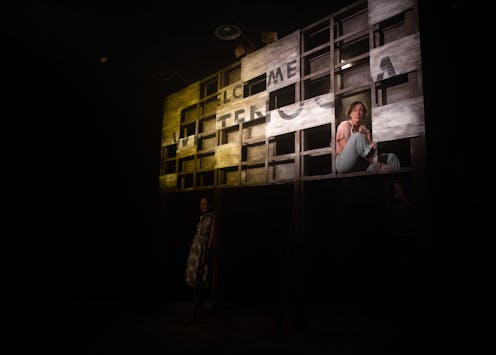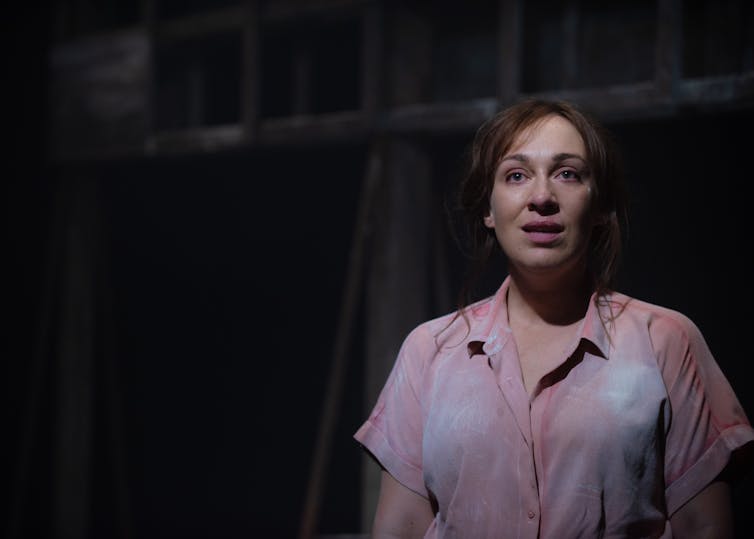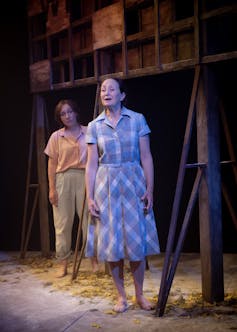Source: The Conversation (Au and NZ) – By Kate Hunter, Lecturer in Art and Performance, Deakin University

Jodie Hutchinson/Red Stitch
Review: Wittenoom, directed by Susie Dee, Red Stitch
Deep in the remote Pilbara region of Western Australia, the town of Wittenoom lies empty, desolate … and contaminated.
Wittenoom is on Banjima country. It was officially established in 1947 as a company town to house those working on the blue asbestos mine in the nearby Wittenoom Gorge. In the 1950s, Wittenoom became Australia’s sole supplier of asbestos. The reported health risks of asbestos led to the shutting down of the mine in 1966 and permanent closure of the town in 2022.
To date, more than 2,000 miners, residents and family members have died from asbestos-related diseases.
Wittenoom, a new play by Mary Anne Butler, is the story of Pearl (Emily Goddard) and her mother Dot (Caroline Lee), who live and work in the town in its functioning heyday of the 1940s.
The pair face a tragic outcome borne of corporate greed and denial.
Read more:
Asbestos still haunts those exposed as kids in mining towns
Dark and spare
As the play opens, Dot and Pearl are perched on the small stage underneath a faded and broken “Welcome to Wittenoom” sign with most of the letters missing. It’s a junky wooden scaffold, propped up with ladders and broken trusses, panels gaping, covered in a fine dust. Pearl begins with a breathy and apocalyptic opening monologue – a lyrical portent that foreshadows the disturbing story to come.

Jodie Hutchinson/Red Stitch
The writing is dark and spare, and the play skips between present and past, shifting from hardscrabble domestic moments to more poetic interludes. Capable, affable Dot opens her house to some of the Greek and Italian mine workers to help them feel at home, even as, over time, the residents of the town begin to question the safety of the mine and the place where they live.
Young Pearl loves her mum, struggles to fit in at school, and grows more and more disturbed by the threat of the mine. These recollections are countered with the horror of a mesothelioma diagnosis and the hard facelessness of the medical fraternity.
As Dot, Lee is confident and centred. Goddard’s performance as Pearl is similarly accomplished, although there is a slightly alarming moment early on when Goddard resorts to that artificial convention of an adult playing a child. This is a brief interlude, fortunately, and for the most part both actors own the space. Together, they are terrific. It is so satisfying to see two performers who match each other’s energy and presence so well.
This presence is complemented by vocally strong delivery and an integrated and embodied physical expression – with each other, with the audience and with the space.
Despite the constrained playing area, there’s plenty of room for the audience to imagine into the world of the play, such is Susie Dee’s specific and attentive direction. Choreographed unison moments of long-recalled gestures and ghostly dances work to hold the piece in a kind of netherworld of memory and sadness.
The sound design by Ian Moorehead is variously heavy and swelling or dark and thunderous, sustained throughout the piece. At times a little tinny, it feels as if there is too much sound in this work, but the long and deep tones at the top of the show establish a suitably ominous feel.

Jodie Hutchinson/Red Stitch
The writing does not shy away from the ghastly medical detail of someone suffering from mesothelioma or the harsh reality that characterises its progression. This grounds the play in an authentic space in which the vulnerability of the human body is laid bare.
The theme of contamination is writ large. The inexorable advance of the disease is manifest as Pearl describes the gobbets of blood coughed up on the floor, the shadows on the lungs, the tumours like tap roots, the tiny poisonous fibres – all while a pale, fine ash gradually settles over the actors’ bodies like bone dust.
Human costs
Wittenoom does have its difficult moments, but Butler’s writing provides enough space and silence to give us time to breathe and Dee’s direction keeps the energetic arc dynamic.
The show is hard and sad, as is the real-life story of many who lived in the town, but it is also necessary. It reminds us of the personal, messy, human cost of such tragedies.

Jodie Hutchinson/Red Stitch
The story of Wittenoom is a stark reminder of the deceptive and immoral practices large corporations maintain in the name of profit. The implications continue to manifest in contemporary Australian life. Asbestos mining was the cornerstone of the housing boom in the 1950s and ‘60s, and many of us grew up – or are still living – in houses built from asbestos sheeting, while companies continue to avoid admission of liability.
The show draws themes of grief, memory and injustice together in an undeniably moving way. It is a powerful and compelling requiem for the people whose lives have been destroyed.
Wittenoom is at Red Stitch, Melbourne, until February 19.
Read more:
Explainer: why the James Hardie asbestos victim compensation fund is running out of money
![]()
Kate Hunter does not work for, consult, own shares in or receive funding from any company or organisation that would benefit from this article, and has disclosed no relevant affiliations beyond their academic appointment.
– ref. More than 2,000 people from Wittenoom died of asbestos-related diseases. A powerful and compelling requiem brings their story to the stage – https://theconversation.com/more-than-2-000-people-from-wittenoom-died-of-asbestos-related-diseases-a-powerful-and-compelling-requiem-brings-their-story-to-the-stage-198779







